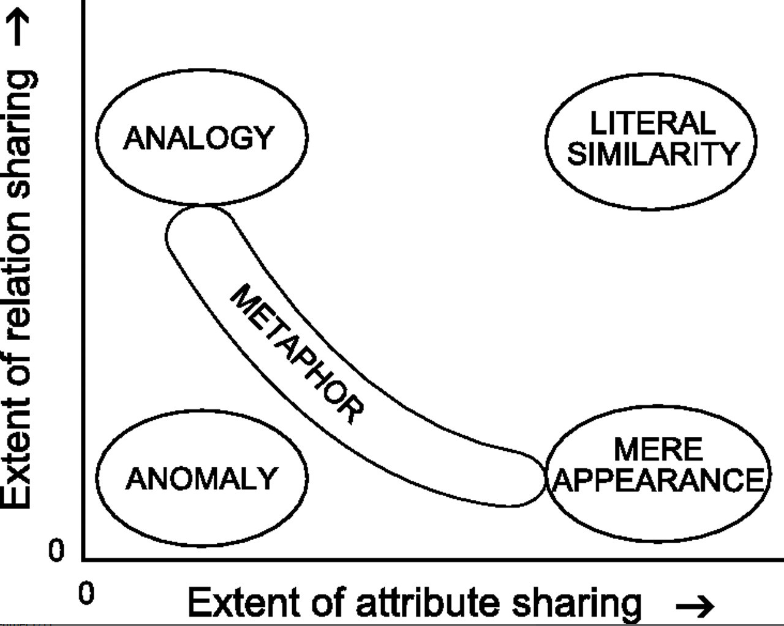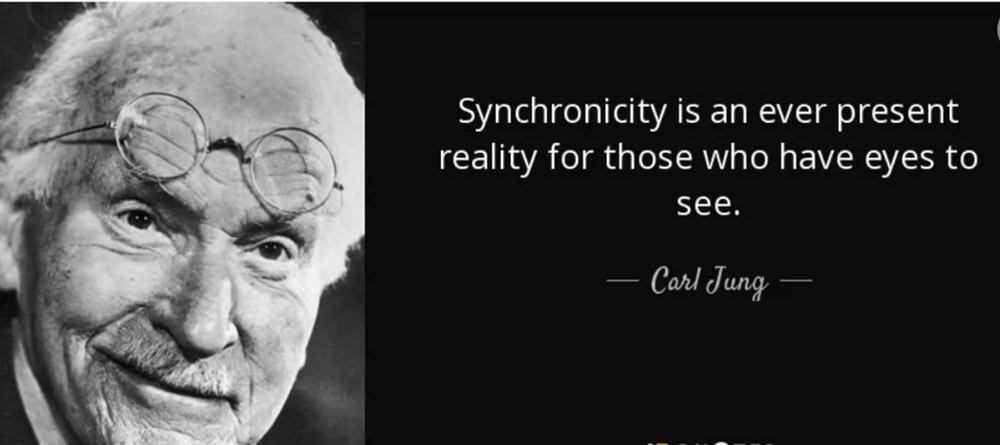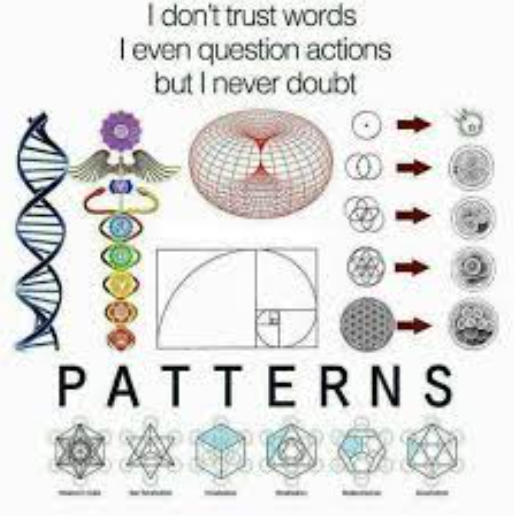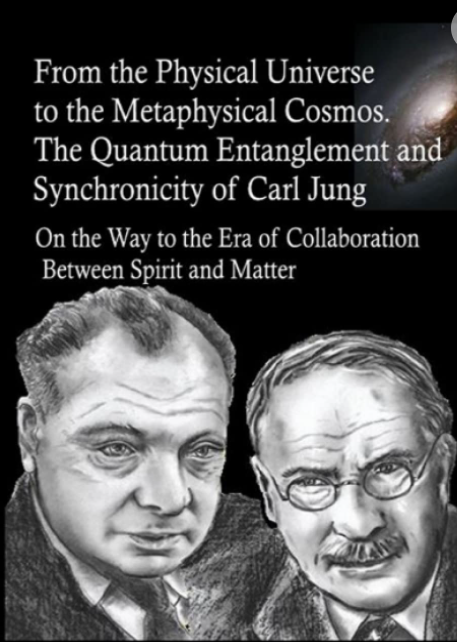Carl Jung’s “mystical” psychological theories [see note 1] are often purely analogical in nature — at least when it came to the way in which he connected them to theories and ideas in quantum physics. Indeed, even in the case of the most positive accounts of Jung’s theories, everything still seems to be purely analogical. What’s more, Jung and his (positive) biographers never really denied (or played down) the analogical nature of his claims about synchronicity’s relation to theories and ideas within quantum physics.

So let’s start off with a simple definition:
“Analogy is a comparison or correspondence between two things (or two groups of things) because of a third element that they are considered to share.”
Despite the title of this essay, it can be freely acknowledged that analogy plays an important role in explanation, conceptualisation, communication, problem solving, perception, argumentation, generalisation, memory, etc.

Indeed, Douglas Hofstadter has said that analogy is “the core of cognition”.
More relevantly, it can also be acknowledged that analogy can be of great help and importance when it comes to scientific theorising. (This is particularly the case in theoretical science and cosmology.) Specifically, analogies can be used in both the applied and the theoretical sciences, and they often take the form of simulations and/or models.
Thus, analogies aren’t always (or particularly) a bad thing. Indeed, even if they were a bad thing in science and philosophy, human beings — including scientists — wouldn’t easily be able to give them up.
In terms of Carl Jung’s work, we can even see the word “analogy” in the following passage:
“This [double-aspect theory] stands in close analogy to quantum physics, where complementary properties cannot be determined jointly with accuracy.”
So when it comes to Carl Jung and Wolfgang Pauli using — and referring to — quantum theory, perhaps we can specifically refer to structure-mapping theory.
In this theory, analogy depends on the “mapping” of the elements of one thing, to another thing. What’s more, that mapping doesn’t only occur between different objects: it also occurs between the relations of these different objects.
However, using the technical term “structure-mapping theory” is perhaps giving Pauli’s and Jung’s analogies too much weight and meat (as we shall see). More importantly, it’s not even always clear if their analogies were meant to be (purely or merely) analogies in the first place.
Perhaps more relevantly to the case of Jung, we’ve had many analogies and metaphors in the philosophy of mind. For example, the mind and/or brain as seen as an aviary, blank slate, factory, telephone exchange, Watt Governor, and (dare I say) a computer.
But herein lies a warning.
Some of these philosophical analogies and metaphors led to long-running mistakes and confusions about the nature of mind. Indeed, many philosophers forgot that they were actually dealing with analogies and metaphors in the first place.
Science and Analogy in Carl Jung’s Work

To most science-savvy outsiders, Carl Jung’s ideas don’t seem to be in the least bit scientific.
However, there are often confusions (or conflations) on this subject which are brought about for two main reasons:
(1) Jung saw what he was doing as being (at least partly?) scientific. (“[Jung’s] preference was to be seen as a man of science.”)
(2) Jung often explicitly refers to science (specifically, in this case, to quantum mechanics).
Of course, Deepak Chopra is always referring to quantum physics too. And some Intelligent Designers often refers to physics, quantum physics, cosmology, and they also use lots of mathematics. You also have “quantum healers”, “quantum soccer players”, “quantum money-makers”, etc. who often refer to (artfully-selected parts of) science.
Added to that, Jung expressed himself in (as it were) scientese.
However, let’s firstly read Harald Atmanspacher expressing Jung’s and Wolfgang Pauli’s ideas in a (seemingly) scientific language. Thus:
“[Jung and Pauli] offered the radical and brilliant idea that the currency of these correlations is not (quantitative) statistics, as in quantum physics, but (qualitative) meaning.”
Is this really a “brilliant idea”? Alternatively, is it simply a brilliant analogy?
What’s more, the analogical nature of this passage just seems obvious.
Now take the words of Jung himself (as found in his The Structure and Dynamics of the Psyche):
“The application of statistical laws to processes of atomic dimensions in physics has a remarkable correspondence in psychology insofar as it pursues the foundations of consciousness to the point where they dim out into the inconceivable [].”
Jung uses the words “correspondence” in the passage above.
Now that’s a problematic word because it’s vague, and it can be interpreted in many different ways.
For a start, anything can be taken to correspond with anything else if mystics, theorists, popular authors, etc. indulge in enough mental gymnastics.
The obvious point to make here is that the “statistical laws [and] atomic dimensions in physics” aren’t said to be one and the same thing as anything in “the foundations of consciousness”.
So what about Carl Jung and his own words on synchronicities?
Carl Jung on Synchronicity

Definitions of “synchronicity” include the following, which are all taken to be faithful to Jung’s own views. (The last definition is from Jung himself.) Thus:
(1) “[A] hypothetical factor equal in rank to causality as a principle of explanation.”
(2) “[A]n acausal connecting principle.”
(3) “acausal parallelism”
(4) “ [A] meaningful coincidence of two or more events where something other than the probability of chance is involved.”
Definition (1) doesn’t say what Jungian synchronicity is. It simply tells us that it has a role in terms of explanation.
Definition (2) is unhelpful. It only tells us that synchronicity is acausal. (Events in the past, numbers, etc. are also deemed to be acausal.)
In terms of (3) (“acausal parallelism” ) — that too is unhelpful. All sorts of things are parallel without needing to be deemed to be either causal or acausal.
For example, if John Smith was born in 1632 in Wigan, and died in 1701 in Barnsley, and Wang Zhang was born in 1632 in Beijing, and also died in 1701 in Shanghai, then is that a case of acausal parallelism?
Similarly, and to slightly change an example from David Hume (see here).
If every morning when a cock crows in Somerset, a man in Wilshire then has sex with his wife, then is that also a case of acausal parallelism?
“meaningful coincidence of two or more events where something other than the probability of chance is involved”.
The word “meaningful” (kinda) gives the game away here.
In other words, this has nothing to do with physics, consciousness, “objective reality”, acausality, etc. Yet this isn’t to deny the importance of meaningfulness. After all, psychologically, such “meaningful coincidences” may be very important for the individual human subjects who note them. However, what have they to do with physics, acausality, mysticism, the paranormal, etc?
Carl Jung on Acausality

The term “acausal” doesn’t seem to do much work either — apart from it (as it were) casting suspicions on the primacy of causal relations, and hinting at the possibility that there is much else besides.
So all this hinges on what commentators mean by “acausality”.
Carl Jung’s notion of synchronicity states that there are “some unknown noncausal connections”.
This bald explanation, in itself, clearly shows why Jung fixed upon entanglement (see later). Yet what we don’t have in physics — not even in quantum physics! — is any talk about “meaningful connections” which are “acausal”.
Sure, there is some talk of acausality in physics, but not of meaningful connections. [See ‘Acausal’. There is ‘retrocausality’ in quantum mechanics too.]
Of course, not many physicists would ever claim that there aren’t any meaningful connections. However, most of them would simply say that such connections aren’t part of physics — or, perhaps, even part of science as a whole. In addition, they may also want to know what the words “meaningful connections” actually mean.
Gerald R. Baron puts the position for acausality (at least as it applies to mystical views) in the following:
“Physicalists reject non-causal events entirely and explain them as coincidences []. To both Jung and Pauli this kind of reductionism could not account for the great accumulation of human experiences, especially what are considered ‘extreme experiences’ including the paranormal.”
[See note 1 on what Baron includes within the square brackets.]
This almost entirely depends on what is meant by “events”. After all, x may be (to use a vague word) connected to y, without that connection also being seen as an event — not even an acausal one — of any kind. Thus, neither causality nor acausality need be brought up here.
To make use of an often-used statement: correlation does not imply either causation or (well) acausation. [See ‘Correlation does not imply causation’.]
So a cock crowing in a farmyard in Totnes, and then a man making love to his wife in Bath, is some kind of connection in that one follows the other. (We can even accept the possibility that it always occurs!) Thus, event x is followed by y. However, x and y don’t make up the very same event. Indeed, x and y may even be “meaningfully connected” by a person (or even collectively connected by many persons), and still not constitute the same event.
However, we should take an example from Carl Jung himself here.
In his book Synchronicity: An Acausal Connecting Principle, Jung cited the example of a patient who dreamt about a scarab beetle, and who then found such a beetle on his desk the very next day.
“Physicalists” (whom Baron refers to) wouldn’t claim that this is either a causal or an acausal connection (or event)…
Except, that is, in the sense that the dream occurred within a physical and causal brain (which Baron may dispute), and the event of a beetle scurrying on the desk is both physical and causal. And, then, a connection was made between the dream and the beetle on the desk. This itself can be explained in terms of a connection between various Jungian ideas about beetles in dreams, and the physical sighting of a beetle scurrying along a desk.
However, let’s go into the specific notion of “meaningful coincidence”.
I can also “meaningfully relate” the death of a mouse to the Big Bang. I can also meaningfully relate being poor (or being rich) with being born on January the 22nd. However, these two meaningful relations don’t have anything to do with contradicting (or going against) causal connections, acausality, entanglement, physics, or even mysticism.
Such “meaningful coincidences” are just things which occur in my mind, your mind, and, perhaps, in more than one mind at once. However, even a “collective” connection between a dead mouse and the Big Bang doesn’t tell us much about either. Neither is the “coincidence” (or connection) mystical, paranormal or acausal.
So there’s no physical or acausal connection between the Big Bang and the mouse’s death. However, there is a physical connection between the ideas, images and concepts of that mouse dying, and the ideas, images and concepts of the Big Bang. Thus, the coincidence isn’t between the actual mouse and the actual Big Bang: it’s between the images, ideas and concepts of the mouse, and the images, ideas and concepts of the Big Bang. Thus, there’s nothing mystical or acausal here at all.
So in terms of accepting this as a “meaningful acausal connection”, readers would need to buy into the entire package (or mystical worldview) of Carl Jung’s psychology. (This isn’t to ignore the fact that psychologists — even Jungians — have taken Jung in new directions.) The story about a dream about a beetle being connected to a beetle on a desk wouldn’t make any sense at all outside a Jungian context.
That alone makes it all very unscientific.
In other words, in order to accept this supposedly acausal connection, one would also have to accept and endorse large parts of a single theorist’s (i.e., Jung’s) overall worldview. In other words, one would need to be a Jungian who accepts Jung’s “analytical psychology”.
Synchronicity in a Wider Context

Yet, despite all the above, some readers who’re unfamiliar with Carl Jung’s notion of synchronicity may believe that the notion is hardly controversial — as least when taken without its (extra?) mystical and acausal baggage.
But let’s not beat about the bush here. As one often-quoted statement has it:
“[Carl] Jung used the concept of synchronicity in arguing for the existence of the paranormal.”
That just quoted, it can now be said the following description of synchronicity is not in the least bit controversial, mystical or paranormal:
“In contemporary research, synchronicity experiences refer to one’s subjective experience that coincidences between events in one’s mind and the outside world may be causally unrelated to each other yet have some other unknown connection. Jung held that this was a healthy, even necessary, function of the human mind that can become harmful within psychosis.”
In a sense, we can compare this contemporary research to Daniel Dennett’s notion of heterophenomenology.
In heterophenomenology, the “verbal reports” of human subjects about their own “subjective experiences” are taken seriously. However, what such subjects say (or claim) about their subjective experiences isn’t (automatically) taken to be true, or to refer to anything actual (or factual) in the world outside their minds. Similarly, “contemporary researchers” analyse and account for selected subjects’ reports of their own subjective experiences. More relevantly, this includes their own reports of what they may call “coincidences between events”, and which they also believe to have “some [acausal] unknown connection”.
However, not all psychologists are heterophenomenologists. More accurately, few counsellors and psychoanalysts are heterophenomenologists. Thus, the passage above continued in this manner:
“One study has shown that both counsellors and psychoanalysts were less likely than psychologists to agree that chance coincidence was an adequate explanation for synchronicity, while more likely than psychologists to agree that a need for unconscious material to be expressed could be an explanation for synchronicity experiences in the clinical setting.”
In other words, some (perhaps most) Jungian psychanalysts take such verbal reports at face value. They also believe that “chance coincidence” (at least in these cases) needs to be explained in terms of “unconscious material”. However, even here, only unconscious material is taken to be (as Jungians put it) “objective reality”…
Objective reality?
Both Jung and Pauli believed that synchronicities (sometimes?) reveal objective reality’s actual workings.
Let Gerald R. Baron be more specific about this objective reality. He writes:
“Jung saw that the ‘inconceivable’ and largely unknowable world of the unconscious mind was a part of objective reality, while our conscious experience deriving in part from our unconscious was subjective.”
So something that is both “inconceivable” and “unknowable” can also be “part of objective reality”. This is an extremely odd use of the term “objective reality”, and it clashes will almost all other uses. (Many philosophers and physicists have a problem with all references to “objective reality”, let alone this Jungian one.) At first sight, it seems like a surreal position, or even a deliberate provocation.
In any case and to repeat: although some of the descriptions (or defences) of synchronicity don’t (on the surface at least) seem to be problematic, it’s still the case that these descriptions (such as the ones just quoted) don’t have anything at all to do with physics, monism, acausality, or even mysticism… except, again, at the level of analogy.
However, what about analogy when it comes to entanglement?
…And, Finally, Entanglement

No one need deny entanglement. Indeed, not many physicists do. However, it’s tying entanglement to “mystical” beliefs, theories and interpretations that’s the issue here. [See note 4.]
When you read the purely physics-based accounts of entanglement (or nonlocality generally), it’s hard to see how any of it can be tied to mystical matters…
But, of course, it has been.
Thomas Filk has argued that quantum entanglement (“a particular type of acausal quantum correlations”) was taken by Wolfgang Pauli to be “a model for the relationship between mind and matter in the framework [which] he proposed together with Jung”. More simply, quantum entanglement was deemed to be a physical phenomenon which “most closely represents the concept of synchronicity”…
Here readers should note the words “model” and “represents”.
Thus, quantum entanglement was taken to be a model “for the relationship between mind and matter” in Jung’s theory. Put another way (as Thomas Filk himself does), quantum entanglement was deemed to “most closely” represent synchronicity.
This means that quantum entanglement has nothing to do with the relationship between mind and matter — except as a model of that relationship. Similarly, quantum entanglement has been used to represent Jungian synchronicity. However, quantum entanglement is not itself Jungian synchronicity. Inversely, Jungian synchronicity doesn’t involve quantum entanglement.
Notes
(1) The words “mystical” and “mystic” have been used throughout the essay above. So it’s worth noting that Carl Jung’s fans and followers have also classed him as a “mystic”. Yet, predictably, other fans and followers have argued that Jung wasn’t a mystic. [See the categorical ‘Carl Jung Was Not a Mystic’.] Indeed, Freud characterised Jung as a “mystic and a snob”.
(2) The square brackets occur around these words:
“[M]ere chance events made possible by a very large number of possible opportunities even if it means multiple universes are needed for a sufficient number of chances.”
I’m not sure how to make sense of that clause, or even if it is relevant to Gerald R. Baron’s overall context. Baron’s words are usually applicable to explaining “fine tuning”, and are about the values of the constants, the nature of the laws of the universe, etc.
(3) Interestingly enough, in the ‘Criticism’ section of the Wikipedia entry ‘Analytic psychology’, all the criticisms of Carl Jung’s views and theories come from fellow psychoanalysts, not from scientists or from philosophers. This hints at the possibility that Jungian psychology is largely ignored by nearly all scientists and philosophers.
(4) In the piece ‘What is the consensus among physicists on whether quantum mechanics has non-locality?’, some commentators argue that there is a “consensus” on nonlocality, and others argue that there isn’t a consensus on nonlocality.
(*) In future essays, I will tackle the role of analogy when it comes to Wolfgang Pauli’s and Carl Jung’s references to quantum nonlocality (already partially discussed), complementarity, and the observer effect.









No comments:
Post a Comment